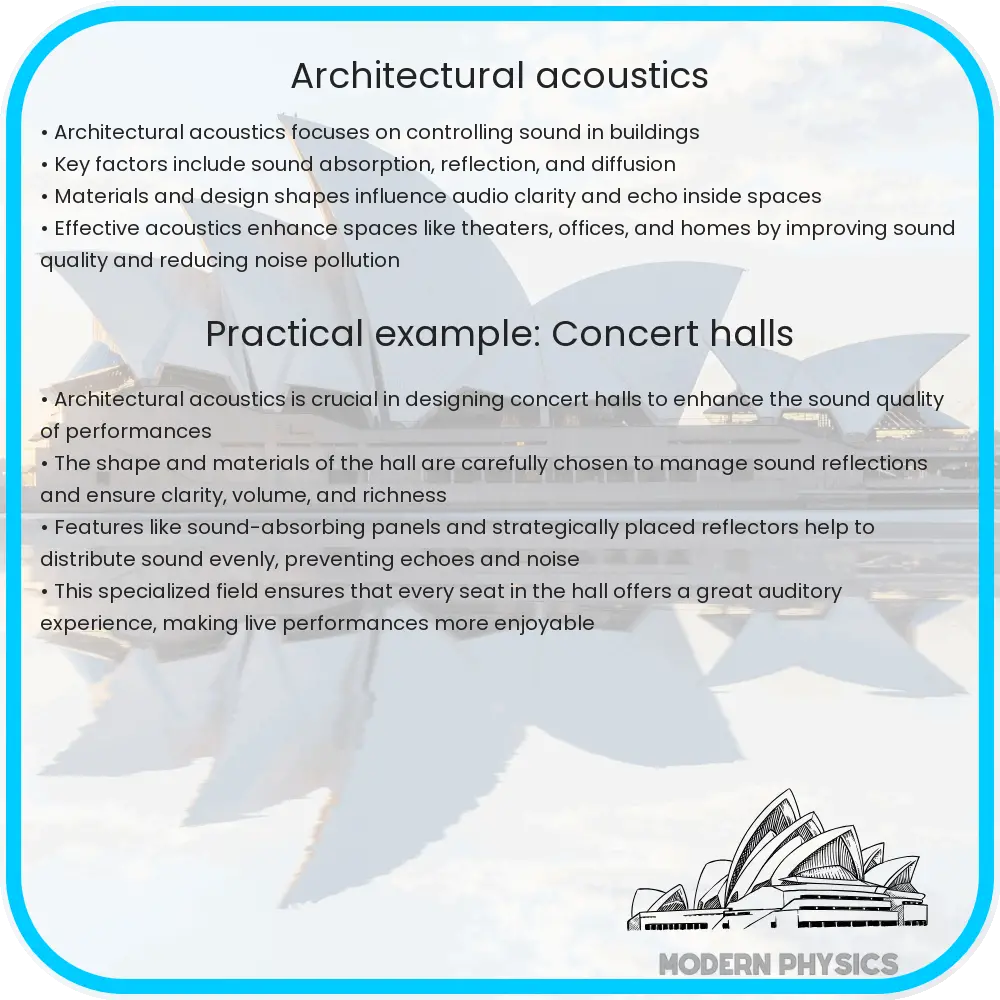Explore how sound behaves in enclosed spaces through the study of architectural acoustics, optimizing environments for their intended uses.

Understanding Architectural Acoustics
Architectural acoustics is an intriguing field of study that focuses on how sound behaves in enclosed spaces. It is a branch of physics and engineering that deals with controlling sound so as to make environments more suitable for their intended uses. The principles of architectural acoustics come into play in the design of concert halls, theaters, auditoriums, and even office buildings and classrooms.
The Design and Significance of Sound in Architecture
One of the primary goals of architectural acoustics is to optimize sound quality, which involves managing both sound transmission and sound absorption. Effective design techniques can enhance clarity, prevent echoes and reverberation, and isolate noises from external sources.
- Sound Absorption: This refers to the process by which a material, structure, or object takes in sound energy when sound waves collide with it, as opposed to reflecting the sound. Materials such as carpets, curtains, and acoustic panels are commonly used to absorb sound.
- Sound Transmission: This involves the movement of sound waves through mediums (e.g., air, doors). Managing sound transmission is crucial in preventing noise leakages between different parts of a building.
To achieve these goals, architects and engineers utilize various materials and construction techniques to manipulate sound characteristics such that they complement the specific function of a space.
Key Principles of Sound in Architectural Design
The design of any space that involves sound comprises several key acoustic considerations:
- Reverberation Time: This is the time it takes for sound to “fade away” in a closed space. It is an essential factor in determining the acoustic quality of a room. Optimal reverberation times vary depending on the type and function of the room; for example, a concert hall will have a longer reverberation time compared to a recording studio.
- Sound Reflection: Hard surfaces can cause sound waves to bounce, which can lead to echoes. Strategic placement of reflective and absorptive materials can help control these reflections and improve sound clarity.
- Noise Reduction Coefficient (NRC): This metric measures the amount of sound a surface absorbs. A higher NRC value indicates better sound absorption.
By leveraging these principles, designers can tailor the acoustic environment to improve overall sound quality, ensuring that sound travels in controlled patterns that are appropriate for the space’s purpose.
Innovations in Architectural Acoustics
Advancements in technology and materials science have led to innovative solutions in architectural acoustics. These innovations aim to address contemporary challenges such as environmental noise control, the varying acoustic needs of multipurpose spaces, and integrating audiovisual technology without compromising on sound quality.
Examples of such innovations include the use of smart materials that can change their properties based on specific needs or environmental triggers, and digital modeling tools that allow architects to simulate and optimize acoustic environments before physical spaces are constructed.
As a further result of innovation, there are designs that include considerations for not only acoustical performance but also for aesthetic and sustainable design, thereby not compromising on the visual and environmental aspects of modern architecture.
The journey into the acoustic quality of a space starts with understanding the role of sound in human perception and ends with the application of complex physics principles in real-world architecture. The confluence of art, science, and technology in architectural acoustics not only creates spaces that sound good but also ones that feel good, enhancing the overall human experience within built environments.
Practical Applications and Case Studies in Architectural Acoustics
Real-world applications of architectural acoustics can be seen in iconic structures around the globe. Case studies such as the Sydney Opera House or the Walt Disney Concert Hall illustrate how acoustically considerate design enhances the sensory experience of users. In these buildings, every architectural detail-from the curvature of the walls to the choice of building materials-was designed to optimize sound quality for musical performances.
- Case Study: Sydney Opera House: Famous for its unique architecture, this landmark is also a marvel in acoustic engineering. Its halls are designed to deliver clear and rich sound, providing an immersive experience for audience members.
- Case Study: Walt Disney Concert Hall: The use of undulating wooden panels along the interior of this concert hall helps in dispersing sound evenly, reducing blind spots and ensuring a balanced acoustic experience from every seat.
These examples underscore the importance of integrating architectural acoustics in the initial design phase to avoid costly retrofits and guarantee optimal audiovisual performance.
Future Trends in Architectural Acoustics
Looking ahead, the field of architectural acoustics continues to evolve with the progression of technology. Future trends include the further integration of digital acoustics, use of AI for modeling and simulation, and the exploration of new materials that dynamically adjust acoustic properties.
An exciting area of development is the use of algorithm-based designs that optimize the acoustic performance of a space based on computer-generated models. This approach not only improves precision but also allows for innovative architectural designs that were previously difficult to execute.
In addition, sustainability in acoustics is gaining traction, highlighting the use of eco-friendly materials and practices in sound design. This shift is crucial as it aligns with global needs for sustainable development while still prioritizing acoustical quality in spaces.
Conclusion
Architectural acoustics is a pivotal aspect of building design that affects how sound is experienced within a space. From the grand auditoriums of the world’s top concert halls to everyday spaces like offices and classrooms, acoustics play a fundamental role in shaping our auditory experiences. By understanding and applying the principles of acoustics, architects and engineers not only enhance the usability of spaces but also contribute to the overall aesthetics and functionality of buildings. The continuous innovations and applications in architectural acoustics show its growing importance in creating environments that are both functionally sound and environmentally sustainable. With future advancements, we can anticipate even more sophisticated acoustical environments that further enhance the quality of our interactions within these spaces.
